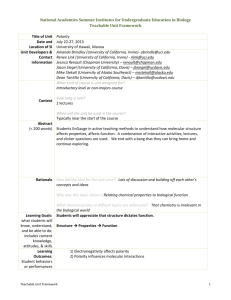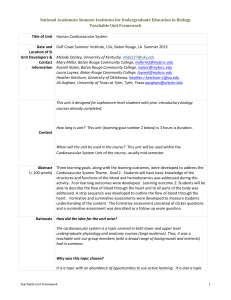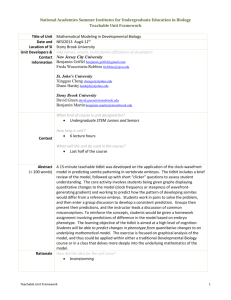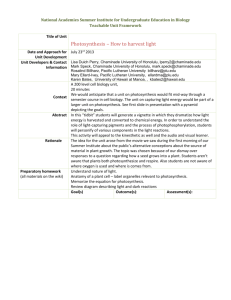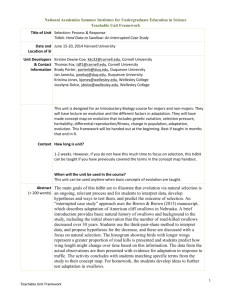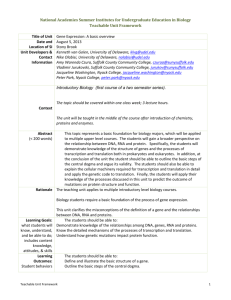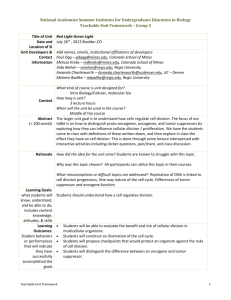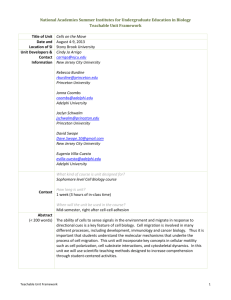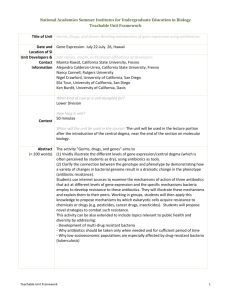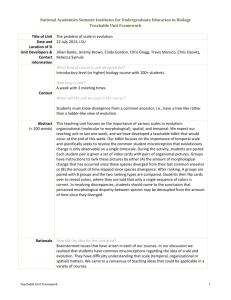Static is Dynamic (framework) Northeast 2013
advertisement
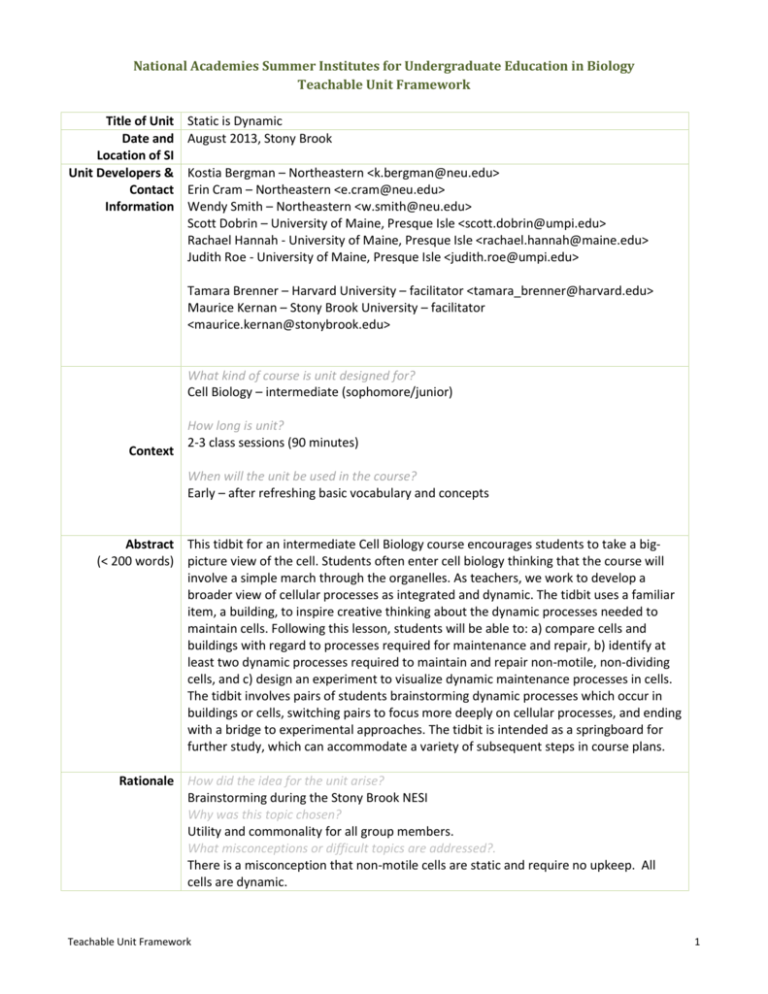
National Academies Summer Institutes for Undergraduate Education in Biology Teachable Unit Framework Title of Unit Date and Location of SI Unit Developers & Contact Information Static is Dynamic August 2013, Stony Brook Kostia Bergman – Northeastern <k.bergman@neu.edu> Erin Cram – Northeastern <e.cram@neu.edu> Wendy Smith – Northeastern <w.smith@neu.edu> Scott Dobrin – University of Maine, Presque Isle <scott.dobrin@umpi.edu> Rachael Hannah - University of Maine, Presque Isle <rachael.hannah@maine.edu> Judith Roe - University of Maine, Presque Isle <judith.roe@umpi.edu> Tamara Brenner – Harvard University – facilitator <tamara_brenner@harvard.edu> Maurice Kernan – Stony Brook University – facilitator <maurice.kernan@stonybrook.edu> What kind of course is unit designed for? Cell Biology – intermediate (sophomore/junior) Context How long is unit? 2-3 class sessions (90 minutes) When will the unit be used in the course? Early – after refreshing basic vocabulary and concepts Abstract This tidbit for an intermediate Cell Biology course encourages students to take a big(< 200 words) picture view of the cell. Students often enter cell biology thinking that the course will involve a simple march through the organelles. As teachers, we work to develop a broader view of cellular processes as integrated and dynamic. The tidbit uses a familiar item, a building, to inspire creative thinking about the dynamic processes needed to maintain cells. Following this lesson, students will be able to: a) compare cells and buildings with regard to processes required for maintenance and repair, b) identify at least two dynamic processes required to maintain and repair non-motile, non-dividing cells, and c) design an experiment to visualize dynamic maintenance processes in cells. The tidbit involves pairs of students brainstorming dynamic processes which occur in buildings or cells, switching pairs to focus more deeply on cellular processes, and ending with a bridge to experimental approaches. The tidbit is intended as a springboard for further study, which can accommodate a variety of subsequent steps in course plans. Rationale How did the idea for the unit arise? Brainstorming during the Stony Brook NESI Why was this topic chosen? Utility and commonality for all group members. What misconceptions or difficult topics are addressed?. There is a misconception that non-motile cells are static and require no upkeep. All cells are dynamic. Teachable Unit Framework 1 National Academies Summer Institutes for Undergraduate Education in Biology Teachable Unit Framework Learning Goals: what students will know, understand, and be able to do; includes content knowledge, attitudes, & skills Learning Outcomes: Student behaviors or performances that will indicate they have successfully accomplished the goals Students will understand: 1. Tissues are composed of specialized cells 2. Structures and functions of cells within tissues are interrelated 3. Cellular specialization depends upon adjacent cells and matrix 4. Maintenance of cellular structure involves dynamic processes Students will be able to: 4a. Draw comparisons between cells and buildings with regard to processes required for maintenance and repair 4b. Identify at least 2 dynamic processes required to maintain and repair non-motile, non-dividing cells 4c. Design an experiment to visualize dynamic maintenance processes in cells Incorporation of Scientific Teaching Themes Active Learning How students will engage actively in learning the concepts Activities outside of class: Before class: Review cellular structures. After class: Read the assigned paper investigating a dynamic cellular process, focusing on Figure 1. –Write a 1-page synopsis of Figure 1: hypothesis, methods, controls, variables, results, conclusion –Outline an experiment using a GFP-labeled protein to study a different process identified by the class. Assessment How teachers will measure learning; how students will selfevaluate learning Pre-assessments: None Post-tidbit assessments: homework Diversity How the unit is designed to include participants with a variety of experiences, abilities, and characteristics •Students bring diverse perspectives to the concept of building maintenance and repair •Activities accommodate multiple learning styles •Activities promote participation by different personality types •Minimal cost Activities in class: Teachable Unit Framework 2 National Academies Summer Institutes for Undergraduate Education in Biology Teachable Unit Framework Introduction by instructor. Tidbit. Activities during tidbit: Pair brainstorm: Pairs of students list or sketch dynamic processes that are needed to maintain cells or buildings Jigsaw: Pairs of students share ideas about dynamic processes needed to maintain and repair cells Assess: Individual students write a 1-Minute Paper describing what they think is the strongest analogy. A more advanced activity would be a short paper critiquing the cells-as-buildings analogy, Sample Presentation Plan (general schedule with approximate timing for unit) Session 1 Time (min) Learning Outcome(s) Teachable Unit Framework Activity/assessment Explanation, notes, suggestions, 3 National Academies Summer Institutes for Undergraduate Education in Biology Teachable Unit Framework tips Preclass Not applicable. Enter approx. class time for learning activity preparatory material presentation Enter approx. class time for a. Draw comparisons learning activity between cells and #1 buildings with 15 minutes regard to processes required for maintenance and repair See accompanying presentation. 2 person brainstorm 2 person jigsaw pair-share Whiteboard or chalkboard b. Identify at least 2 dynamic processes required to maintain and repair nonmotile, non-dividing cells Group Share/ teacher wraps up c. Design an experiment to visualize dynamic maintenance processes in cells Homework assignment (highlevel Bloom’s) Teachable Unit Framework Needs: Paper, writing implements, imagination One-minute paper 4 National Academies Summer Institutes for Undergraduate Education in Biology Teachable Unit Framework Enter approximate time for additional learning activities and associated class Work/preparatory materials Students could bring in pictures of buildings to share. Blank paper; colored sticky notes Enter approximate time for post-activity summing up or transition We have envisioned that in the next class period students will design experiments to investigate dynamic processes within cells. Add additional activities information as needed for the unit. Resources for Teaching the Unit (other files and information needed/helpful to teach the unit, including files for papers from which original data for class activities is taken, supporting information for the instructor, handouts, in class activities materials, assessments with answer keys, homework assignments, etc.) We suggest the paper: Kreitzer et al., 2003. Three-dimensional analysis of post-Golgi carrier exocytosis in epithelial cells. Nature Cell Biology 5: 126-136. DOI: 10.1038/ncb917 You can choose any paper that fits in with your teaching unit. Effectiveness of unit (if you have used it in your own teaching) Acknowledgements Teachable Unit Framework 5 National Academies Summer Institutes for Undergraduate Education in Biology Teachable Unit Framework (Facilitators, others who gave input, information, etc.) Tamara Brenner and Maurice Kernan, and our fellow participants in the Stony Brook Summer Institute 2013 Teachable Unit Framework 6

